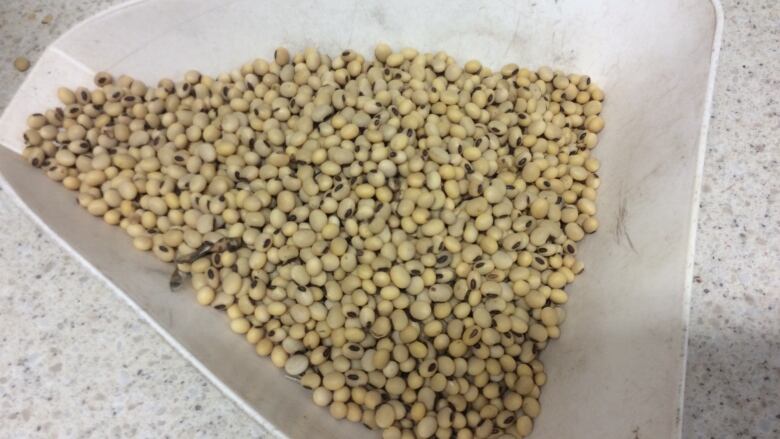'I've never seen this': Wet weather leaves some soybeans unharvested
About 810 hectares on P.E.I. were not harvested, which could mean up to $80K in losses

There are about 10centimetresof soybean stems poking through Norman Cairns field in Stanchel, P.E.I., and he's not happy about it.
Soy farmers on the Islandlost more than their fair share of crop and money this year after rain and snow kept them from harvesting the beans in time.
Cairns owns about 66hectaresbut only harvested sixthis year because of the weather.
"I've never seen this. We've never left crop in the field before," he said.
Wet beans swell up
When it rains too much, soybeans take on moistureand swell up into a football shape, said Neil Campbell, manager of the P.E.I. Grain Elevators Corporation.

Once they reach that point, they are too wet to go through the dryer and lose quality grades, so farmers leave them in the field to dry naturally.
The beans can be harvested at moisture levels below 20 per cent, but last week they were around 27 per cent, he said.
It also costs money to dry the beans manually, so farmers often risk a later harvest, he said.
This yearthe rain never let up for long enough, and now the beans are frozen in the snow.
- 'Filled to the rafters':Summersidesoybean shipment good news for farmers and port
- Soybean prices rally as P.E.I. farmers prepare to plant
"We seem to have an old-fashioned winter. We got snow this year, earlier than normal," he said. "The guys were waiting for a small window to get into the fields and that was hard to find."
Up to $80Kin losses
The majority of soybean fields in P.E.I.are located in the eastern part of the Island, with some in the middle and about 40hectaresin the west.

Campbell said about 810 hectares on the Island were not harvested, which could mean up to $80,000 in losses. There will also be no exports to Quebec this winter, he said.
There is a silver lining, though:If it starts to rain and unfreezes the beans, the farmers could still salvage some of the crop.
"If we come in with a rain now and bared off the soil, and then it froze, they could go in and cut them and salvage them like they did three years ago," he said. "They waited, they cut over the Christmas break and into New Year's actually."
Changing the crop
Campbell added producers may consider planting a different kind of soybean that they can cut earlier.

Farmers can also get some of their money back if they have crop insurance, he said.
- MORE P.E.I. NEWS |'I nearly got run down': Stratford man wants lights installed at new crosswalk
- MORE P.E.I. NEWS |Charlottetown alarm bylaw beefed up
With files from Nancy Russell












_(720p).jpg)


 OFFICIAL HD MUSIC VIDEO.jpg)
.jpg)



























































































